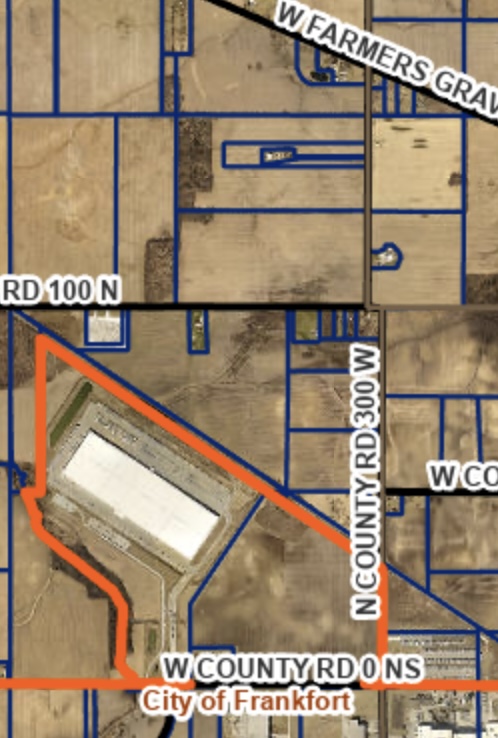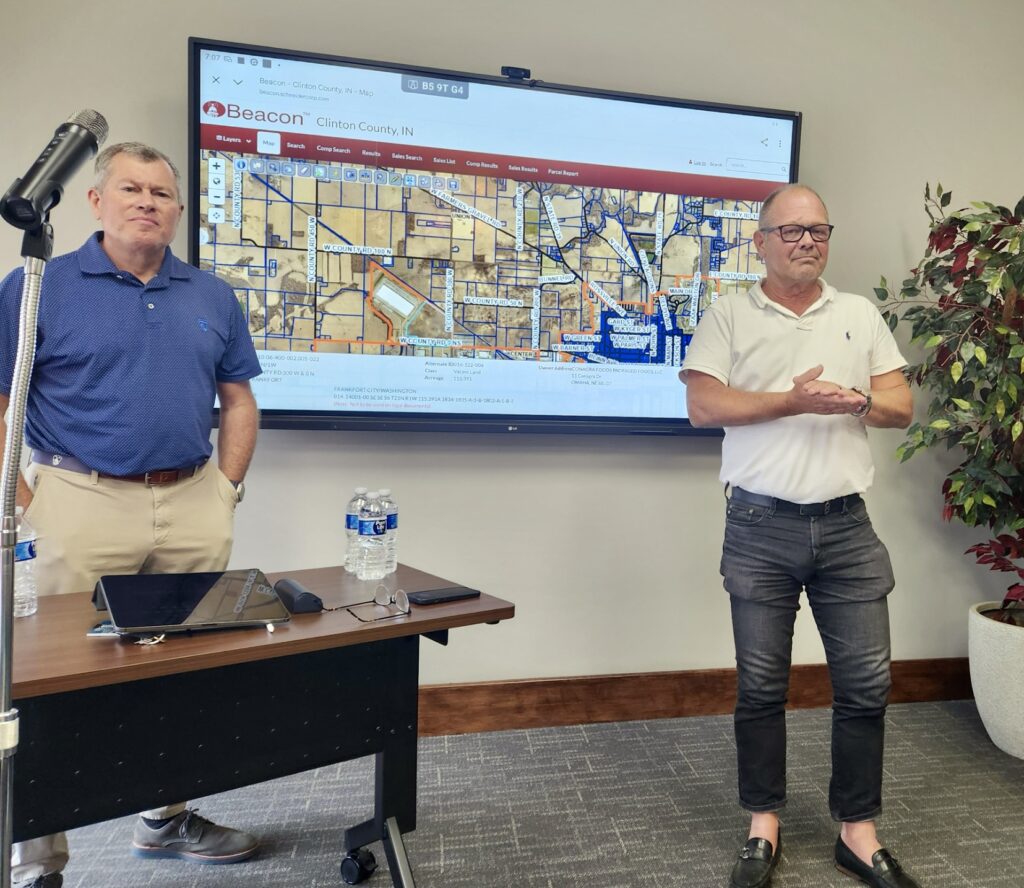Doug Swain, President of Logistix Property Group met with landowners and other stakeholders of the proposed 700+ Acre, 7 million square foot Data Center project Tuesday evening in the Conference Room of the Chamber of Commerce Iron Block Building. The meeting lasted about 90 minutes. Most of the meeting was in a Question-and-Answer format after a brief explanation of the Project by Swain.
Doug Swain with Logistix Property Group helped put the ConAgra project together in Clinton County several years ago. Swain is familiar with several benefits and characteristics of the area including utilities, land use, governmental interests, requirements and other variables.

The proposed Data Center would be “bundled” by Logistix and presented to a few well capitalized High-Tech firms such as Meta, Amazon, or other well capitalized companies. The company that would eventually own the data center would be “recognized” but all parties are currently under an NDA (Non-Disclosure Agreement).

There are over 2,500 data centers in the United States. The interest in the Frankfort, Indiana location includes:
- Proximity to Purdue University
- Proximity to Indianapolis Metro Market
- Favorable Taxes in Indiana including no sales tax on services supplied by a data center
- Favorable Business environment in Indiana and Clinton County
- Permissive Variables in place such as power, water, access to skilled labor force, interstate access for easy transportation and accessibility. Airport NOT specifically mentioned but Frankfort/Clinton County Regional Airport is less than one mile from site with 4/22 and 9/27 (5000’x75’) runways and deicing capabilities with Jet A Fuel truck.
- Proximity to Rose-Hulman Institute of Technology and other advanced technical schools
- Familiarity of the area and its advantages known from the ConAgra project
The 10 biggest data centers in the U.S. currently are:
1) Northern Virginia
2)Phoenix
3) Silicon Valley
4) Dallas
5) Chicago
6) Atlanta
7) Washington D.C.
8) New York Tri-State area
9) Miami
10) Los Angeles
For comparison, the average size of a US data center is 40 MW, expected to be 60 MW by 2029, according to Boston Consulting Group. About one third of all Data Centers in the U.S. are above 200 Mega Watts. The proposed data center for Frankfort, by any measure, would be large, consuming up to 600 MW. The largest data center in the United States is owned by Meta Platforms in Prineville, Oregon spanning 4.6 million square feet. The proposed data center would be located in several buildings and encompass up to 7 million square feet. If this information from WaveTech is current, this would make the Frankfort, Indiana data center one of the largest, if not THE largest data center in the United States, if built out to its maximum multi building plan of 7 million square feet. For comparison, the ConAgra building is 1.6 million square feet.
The proposed data center in Frankfort/Clinton County, if approved, would be built in phases lasting up to 3-5 years for the later phase. Phase one, if approved, could be started “soon”.

When the project surveillance started, Swain was expecting a 100-acre, 200 acre or maybe 300-acre project. The scope of the project is now at the 700+ acre level with power consumption totaling as much as 600 Megawatts and perhaps 10 billion Dollar investment. According to Logistix, the formula for number of employees at any data center project is “1/2 job per Megawatt”. Thus, a 600 MW Data Center would yield 300 direct jobs. Indirect jobs could be an additional 3x this amount, yielding over 1000 jobs possible.
Since there is no project, no confirmed buyer and no approval at this time, many unknowns exist. The audience of some 30 individuals had many questions and doubts about the proposed project.
- What are the water requirements and what impact will that have on the community’s ability to maintain its water supplies? Swain said later generation data centers are trending less water use for cooling needs. Some data centers “are air cooled now” Swain said. Any water requirements of the project are sufficiently filled by Frankfort utilities for the project to be built. “Pump and dump” water cooling is not common on modern data center facilities. “New cooling technologies” dominate trade shows for companies interested in the latest developments in the data center industry.
- What about noise pollution? What kind of neighbor would the data centers become for the peace of the nearby landowners? Swain said decibel levels would be near that of road traffic. (Heavy Road traffic with car and truck mix at 300 feet equals 60 dB(A). This is similar to a dishwasher in the next room according to indot.illinois.gov.
- What data centers can be visited that are similar to this proposed data center so residents can visit them and get information on compatibility with the neighborhood? Swain did not have a particular data center in mind “that is in this state” that is similar in size and technological advancement but agreed farther travel could be done and could answer some questions. Swain said, “you may have to at least go to Ohio”.
- What about light trespass, light pollution? Clinton County has a lighting ordinance that prohibits light levels above the horizon level, requiring “full cut off”. ConAgra complied with this ordinance, protecting the Camp Cullom Astronomical Observatory (Prairie Grass Observatory 19,200 feet to the northwest of data center project) and passing traffic. The ordinance also limits light temperature and tower strobes at night to protect the night skies. Swain expected similar compliance with this project.
- Will landowners nearby be given a chance to sell property at favorable prices that allow for disruption, future access to satisfactory home, aggravation of the move, etc.? James Shook, Jr. with Shook Realty Group in Indianapolis is making calls on existing landowners in the area. Only time will tell if landowners are satisfied.
- Why did the project “go north of ConAgra instead of east” to cluster the project closer to the industrial area and stay clear of rural area? Swain said this northern reach was centered on “proximity to the future substation” and power considerations.
- Several minutes were spent talking about the kind of jobs available, whether these jobs would be local or remote and the longevity of these jobs and the longevity of the structures themselves and if they would be subject to obsolescence in a few years. Swain said jobs would average about $100,000 annual salary. Many positions would have to be local and have to be highly skilled positions. This is why the center is located close to Purdue, Rose-Hulman, other technical schools. Longevity is secure, in his mind, since AI is just getting started and buildings can install new technologies inside the expensive structures every few years.
- The project would increase assessed valuation considerably in Clinton County, having a large impact on tax revenue for the City and County. Swain was asked what financial impact it would have and he said, “we are studying that right now”.
- Swain said if the project is approved, additional power line(s) to the substation may need to be strung. It was not discussed where these additional lines would be strung.
The next step for this project is a plan commission meeting on the July 23 followed by a city council meeting on Monday, August 11.
